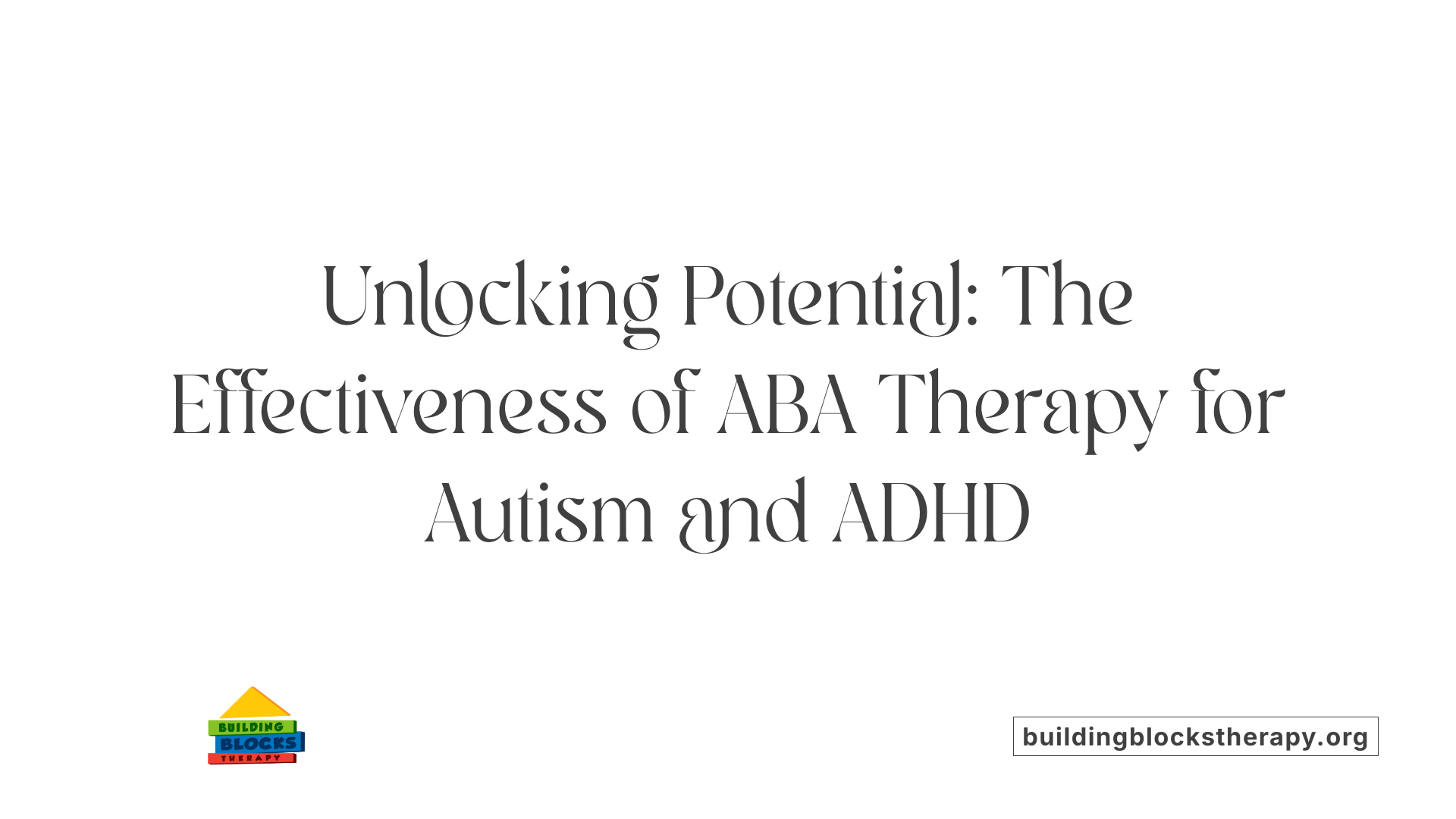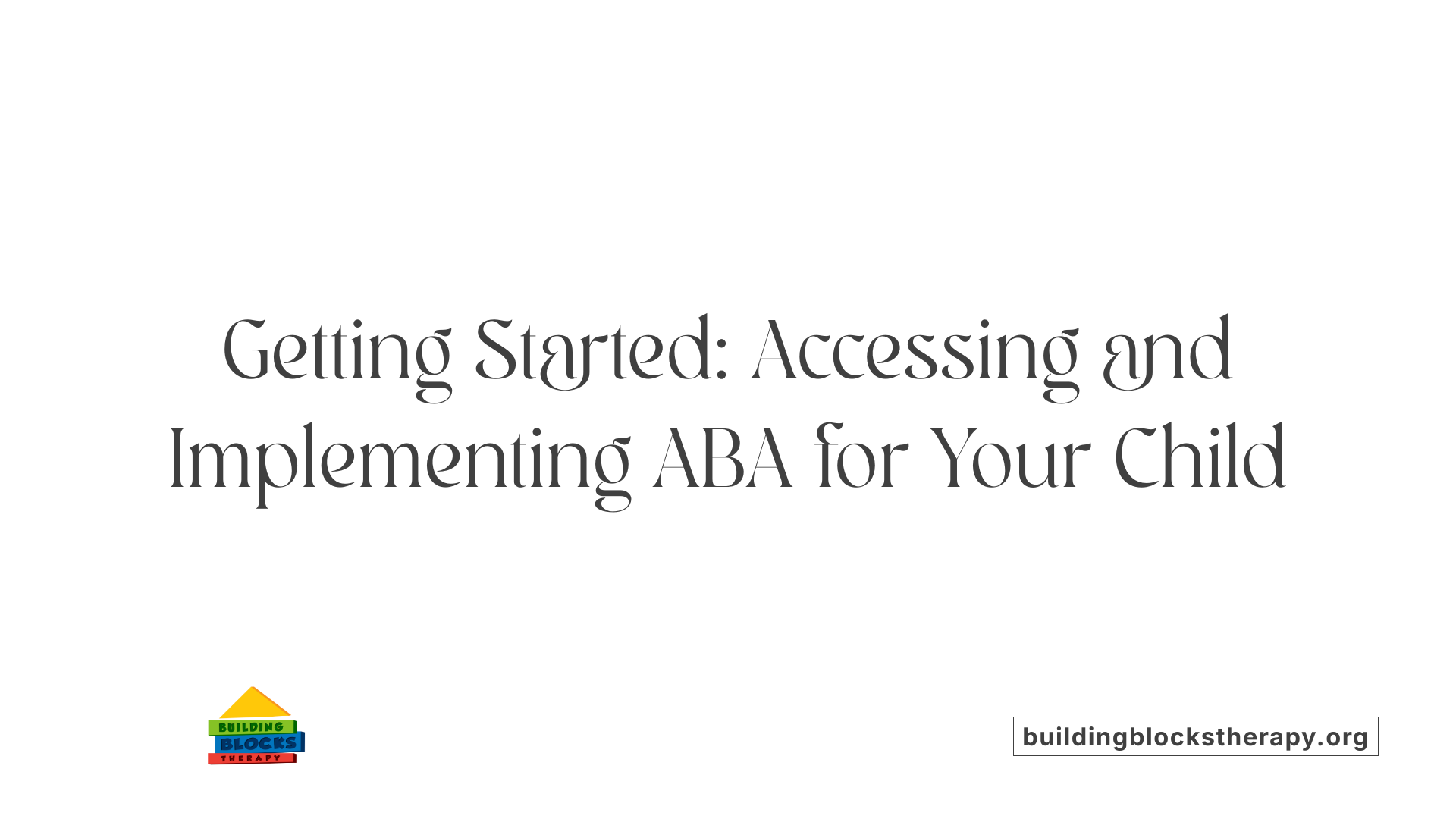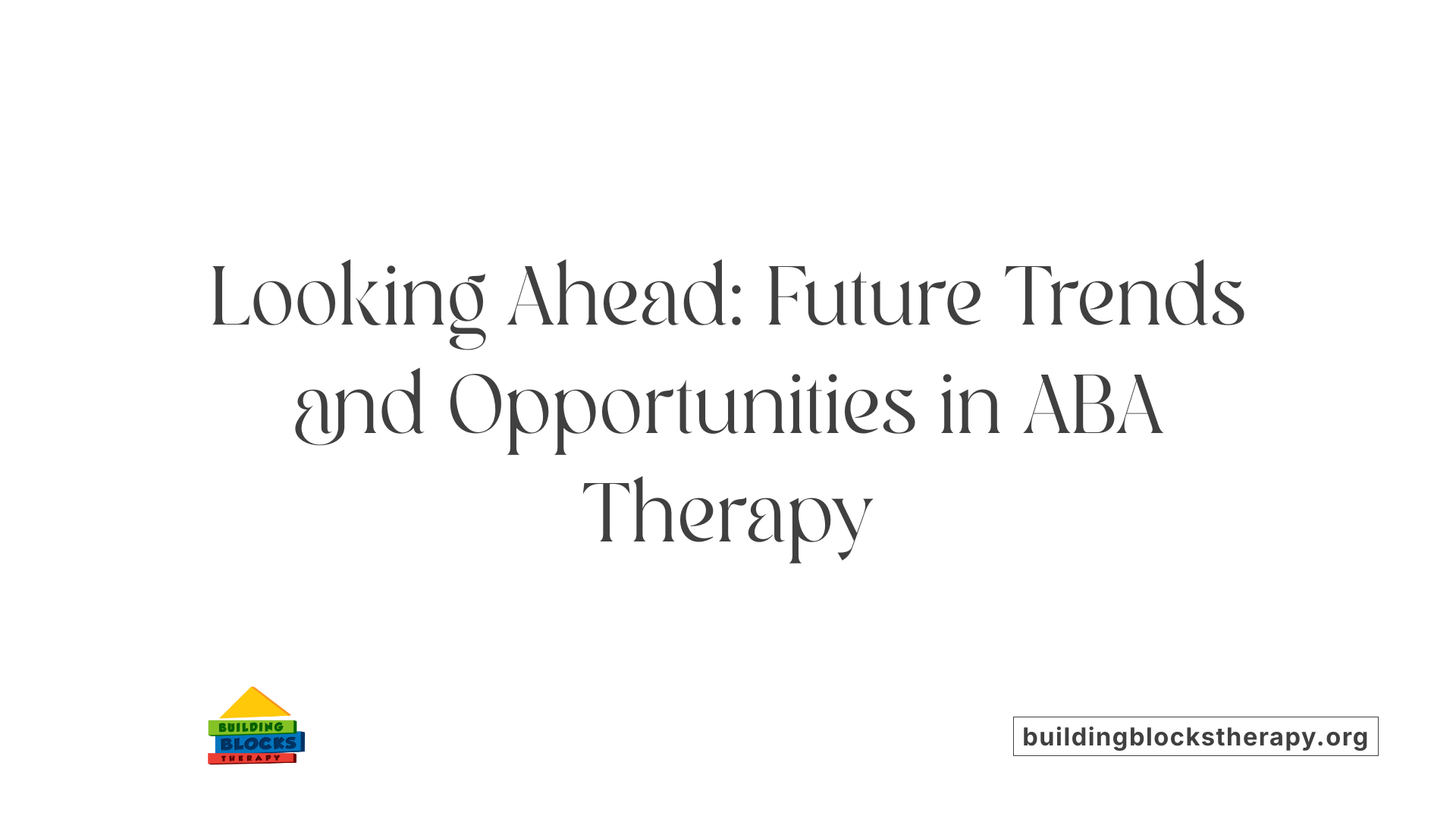ABA for Autism and ADHD
Unlocking Potential: The Role of ABA in Managing Autism and ADHD

Understanding ABA as a Foundation for Behavioral Support
Applied Behavior Analysis (ABA) stands as a cornerstone in behavioral therapy, especially for children with autism and ADHD. Rooted in the science of learning and behavior, ABA employs structured strategies to foster positive skills and diminish problematic behaviors. Recognized as an evidence-based, gold-standard intervention, ABA emphasizes individualized treatment plans that adapt to each child's unique needs, promoting their participation and independence in society.
What is ABA and Its Therapeutic Application for Autism and ADHD
What is Applied Behavior Analysis (ABA) and how is it used as a therapeutic approach for autism and ADHD?
Applied Behavior Analysis (ABA) is a well-established scientific approach aimed at understanding and changing behavior through the principles of learning. It uses behavioral techniques to promote positive behaviors and lessen problematic ones, focusing on environmental influences that shape actions.
In practice, ABA involves creating individualized treatment plans developed by trained professionals known as behavior analysts. These plans utilize various strategies such as positive reinforcement—rewarding desired behaviors to encourage their repetition—and detailed analysis of antecedents (what happens before a behavior) and consequences (what happens after a behavior).
ABA's effectiveness has been extensively supported by research, earning recognition as the "gold standard" therapy for individuals with autism. It helps improve communication, social skills, daily living skills, and decreases harmful behaviors. For children with ADHD, ABA techniques assist in managing impulsivity, improving attention, and developing self-control.
Common techniques include differential reinforcement of behaviors, discrete trial training, task analysis, and self-management training. Some approaches, like Pivotal Response Training, focus on motivation and social engagement in natural settings.
The therapy is highly adaptable, often involving parents and caregivers in training to support consistent behavior management across different environments such as home, school, and community. Overall, ABA provides a versatile, evidence-based framework for fostering learning, independence, and better quality of life for children with autism and ADHD.
Techniques and Methods in ABA Therapy for Autism and ADHD
ABA therapy utilizes diverse strategies tailored to individual needs, aiming to foster positive behaviors and diminish problematic ones in children with autism and ADHD.
One of the most fundamental techniques is positive reinforcement. This involves rewarding desired behaviors, which increases the likelihood of these behaviors recurring. Rewards can include praise, tangible items, or privileges, and are carefully chosen to motivate the child.
A central approach within ABA is Discrete Trial Training (DTT). DTT decomposes complex skills into small, manageable steps and delivers structured prompts and consequences for each step. This method promotes learning through repetition and clear expectations, especially effective for skill acquisition.
Modern ABA also emphasizes naturalistic teaching approaches such as Pivotal Response Treatment (PRT). PRT takes place in everyday settings like home or school and focuses on pivotal areas like motivation and social initiation. This method encourages children to develop foundational skills that improve overall functioning.
In addition, skill-building tools such as Picture Exchange Communication System (PECS) and Functional Communication Training (FCT) are employed to enhance communication, especially for non-verbal children. Visual aids, such as picture cards and charts, help children understand and express themselves.
Token economies and consistent reinforcement schedules are practical tools used across interventions. These systems provide tangible tokens or points that children can exchange for reinforcers, promoting engagement and independence.
Behavior analysts often combine these methods with observational assessments and data collection to tailor interventions and track progress. When integrated, these ABA techniques help children with autism and ADHD develop social, communication, and daily living skills, supporting their growth and independence in various environments.
Effectiveness and Outcomes of ABA Therapy

How effective is ABA therapy for children with autism and ADHD?
Research consistently demonstrates that Applied Behavior Analysis (ABA) is a highly effective and evidence-based approach for children with both autism spectrum disorder (ASD) and Attention Deficit Hyperactivity Disorder (ADHD). The therapy’s primary goal is to foster positive behaviors while reducing problematic ones, which directly supports children in developing essential social, communication, and adaptive skills.
Studies and meta-analyses have shown that ABA can lead to small to moderate improvements across multiple developmental domains. For children with autism, longer durations of ABA—often between 12 to 24 months or more—are associated with more meaningful progress. In the case of ADHD, ABA techniques such as differential reinforcement and self-management training can effectively help children develop better impulse control, focus, and social interactions.
Early and intensive ABA interventions tend to produce the best outcomes. For example, children who begin therapy at a young age and receive 25 to 40 hours per week — typically lasting 1 to 3 years — often show significant gains in language, social skills, and daily living skills.
While the quality and consistency of therapy are critical factors, individual differences among children, including baseline skills and motivation, also influence results. Properly structured ABA programs overseen by qualified professionals like Board Certified Behavior Analysts (BCBAs) ensure that interventions are personalized and adjusted as needed.
In summary, ABA’s solid foundation of scientific support makes it one of the most effective methods for promoting social, behavioral, and functional improvements. When combined with medication and other interventions, ABA can be even more effective in helping children reach their full potential.
Accessing and Implementing ABA Services

How can families access and implement ABA services for autism and ADHD?
Families seeking ABA therapy for autism or ADHD can start by consulting healthcare providers, school districts, or private clinics that offer behavioral services. It's important to choose qualified professionals, particularly licensed or credentialed Board Certified Behavior Analysts (BCBAs), who design and oversee personalized treatment plans.
Insurance coverage plays a significant role in accessing these services. Many private insurance plans and Medicaid provide coverage for ABA if it's prescribed as medically necessary. Families should review their insurance policies carefully and contact insurers directly to understand their benefits and any coverage limitations.
Once access is secured, the implementation process involves several steps. First, a comprehensive assessment is conducted by a BCBA, including interviews, observations, and functional behavior assessments. Based on this, a tailored treatment plan is developed with specific goals in areas like communication, social skills, attention, and daily living.
Parents and caregivers are vital to the success of ABA. They participate actively by applying learned strategies, such as positive reinforcement, prompts, visual aids, and structured routines, to support skill acquisition and behavior management at home and school. Consistency and collaboration with trained professionals ensure effective reinforcement of desired behaviors.
Ongoing progress monitoring is essential. Regular data collection, review sessions, and adjustments to strategies help keep interventions aligned with the child's evolving needs. With this combined approach of professional guidance and consistent family involvement, ABA can significantly improve outcomes for children with autism and ADHD.
Historical Development, Criticisms, and Modern Practices

What is the historical background of ABA therapy, and what criticisms and modern practices exist?
Applied Behavior Analysis (ABA) therapy was initially developed in the 1960s, primarily through the work of Dr. Ivar Lovaas and other early behaviorists. Its roots trace back to classical behaviorism pioneered by psychologists like John Watson and B.F. Skinner, who emphasized the science of behavior modification using environmental stimuli.
Early ABA programs were highly structured, intensive, and sometimes involved aversive techniques aimed at reducing problematic behaviors. These methods focused heavily on compliance and conformity to societal norms, often employing punishment or negative reinforcement.
Over the decades, the field of ABA evolved significantly. Modern practices have shifted away from punitive methods toward positive reinforcement, emphasizing respect for the individual’s dignity and naturalistic, play-based interventions. This shift reflects a broader understanding of ethical standards and a commitment to supporting the child's well-being.
Contemporary ABA practices are personalized, considering each child's strengths, interests, and needs. They involve less repetition and more naturalistic teaching strategies, sometimes called developmentally appropriate or play-based approaches. Family involvement and self-advocacy are now central to effective therapy.
Despite its strong evidence base, ABA has faced criticism, particularly from parts of the autistic community. Critics argue that earlier forms of ABA prioritized making autistic children appear neurotypical, sometimes at the expense of their natural behaviors and identities. Concerns include the use of punishment, suppression of behaviors like stimming, and a one-size-fits-all approach.
In response, many practitioners and advocates advocate for ethical, participant-centered ABA that promotes independence, skill development, and positive self-expression. Modern standards emphasize informed consent, ongoing family involvement, and minimizing discomfort or distress.
Today, ABA is recognized as an evidence-based treatment for autism and ADHD, with ongoing debates about the best methods and goals. While it remains highly effective for teaching new skills and reducing problematic behaviors, the focus continues to evolve toward respecting neurodiversity and facilitating meaningful participation in society.
Overall, the history of ABA is marked by significant improvements in ethical standards and therapeutic techniques, aligning the practice more closely with contemporary values of autism acceptance and individualized support.
ABA for Autism and ADHD: Complementary Treatments and Future Directions

How does ABA integrate with medication and other therapies?
ABA (Applied Behavior Analysis) is recognized as an effective therapy for both autism spectrum disorder (ASD) and ADHD. It focuses on behavior modification based on principles of learning science, employing strategies like positive reinforcement, task analysis, and differential reinforcement.
For children with ADHD, ABA is often used alongside medication, with research supporting that the combined approach yields the best outcomes. While medication can help manage chemical imbalances, ABA addresses behavioral responses, impulsivity, and social skills.
ABA techniques can be adapted to work in various settings such as home, school, and community, providing a comprehensive approach to treatment. A collaborative effort among healthcare providers, teachers, and parents, overseen by a BCBA (Board Certified Behavior Analyst), ensures that interventions are tailored to each child's needs.
Can ABA help in reducing medication dependence?
Many experts suggest that intensive and long-term ABA therapy can potentially lessen the reliance on medication over time. By teaching children new skills, improving self-regulation, and reducing disruptive behaviors, ABA supports the development of coping strategies that can complement or, in some cases, diminish the need for medication.
However, it's important to view ABA as part of a broad treatment plan. Some children benefit from continued medication, especially in managing severe symptoms, but the goal of ABA is to empower children with skills that promote independence and improved functioning.
What are emerging research directions and innovations?
Ongoing research is exploring newer ABA methods that are more naturalistic and child-led, such as pivotal response training (PRT) and play-based approaches. These methods aim to increase motivation and social engagement by emphasizing fun and relevance.
Innovations include integrating technology like apps and virtual platforms to deliver interventions and monitor progress more efficiently. Researchers are also studying how ABA can better address diverse needs, including neurodiverse perspectives and cultural differences.
Future research is focusing on enhancing individualization, making ABA more flexible, and exploring how it can effectively combine with emerging therapies such as social skills training, mindfulness, and sensory integration.
| Area of Focus | Current Trends | Future Directions |
|---|---|---|
| Integration with medication | Combined use in treatment plans | Personalized, adaptive approaches |
| New ABA methods | Traditional DTT and PRT | Play-based, naturalistic, and tech-assisted therapies |
| Research advances | Evidence supports long-term benefits | Greater individualization and cultural adaptation |
These developments point toward a future where ABA continues evolving to meet diverse needs, integrating seamlessly with other treatment modalities to optimize outcomes for children with ASD and ADHD.
Concluding Thoughts and Future Perspectives

What is the future outlook for ABA therapy in supporting children with autism and ADHD?
The future of ABA therapy looks optimistic as both researchers and practitioners work towards refining techniques and broadening our understanding. An important trend is shifting towards more naturalistic, play-based, and community-focused interventions, making therapy more engaging and accessible for children.
Emerging innovations aim to balance skill acquisition with acceptance and self-expression. Therapies are increasingly respecting neurodiversity, emphasizing individuality rather than conformity to neurotypical behaviors. This approach advocates for fostering autonomy and celebrating natural behaviors like stimming.
Collaboration across disciplines—such as psychology, education, and healthcare—along with increased advocacy from neurodiverse communities, will play a vital role. Evidence supports combining ABA with medication, social supports, and educational accommodations to create more comprehensive, personalized treatment plans.
Overall, advancements aim to maximize positive outcomes for children while respecting their dignity and uniqueness. The ongoing evolution of ABA as a flexible, evidence-based, and ethically responsible approach promises a more inclusive future where children with autism and ADHD can thrive.
Moving Towards Inclusive and Evidence-Based Support
ABA remains a vital and adaptable therapy for children with autism and ADHD, underpinned by a strong scientific foundation and constantly evolving to meet the needs of neurodiverse individuals. Its techniques and principles enable meaningful skill development, independence, and societal participation. As debates and research continue, the emphasis on ethical, person-centered practices ensures that ABA fosters respect, autonomy, and dignity. The ongoing integration of innovative approaches and multidisciplinary collaboration promises a future where ABA supports not just behavioral change but also acceptance and empowerment for all children.
References
- ABA Therapy for ADHD Treatment - Manhattan Psychology Group
- Applied Behavior Analysis (ABA) | Autism Speaks
- ABA Therapy for ADHD: Strategies to Improve Focus & Behavior
- The Controversy Around ABA - Child Mind Institute
- Treatment and Intervention for Autism Spectrum Disorder - CDC
- ABA Therapy Benefits for all Ages: From Autism to ADHD - Well Clinic
- Applied Behaviour Analysis (ABA) and autistic children
- ABA Therapy for ADHD: Effective Strategies for Kids
- ABA Therapy for ADHD/ADD - Award Behavioral Health






